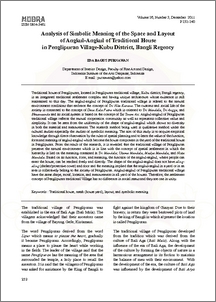Ida Bagus , Purnawan
(2011)
ANALYSIS OF SIMBOLIC MEANING OF THE SPACE AND LAYOUT OF ANGKUL-ANGKUL OF TRADITIONAL HOUSE IN PENGLIPURAN VILLAGE-KUBU DISTRICT, BANGLI REGENCY.
Mudra (JURNAL SENI BUDAYA), 26 (3).
p. 1.
ISSN 0854-3461
![[img]](http://repo.isi-dps.ac.id/style/images/fileicons/application_pdf.png)  Preview |
|
PDF (ANALYSIS OF SIMBOLIC MEANING OF THE SPACE AND LAYOUT OF ANGKUL-ANGKUL OF TRADITIONAL HOUSE IN PENGLIPURAN VILLAGE-KUBU DISTRICT, BANGLI REGENCY)
- Published Version
Download (1MB)
| Preview
|
Abstract
Traditional house of Penglipuran, located in Penglipuran traditional village, Kubu district, Bangli regency, is an integrated traditional settlement complex and having unique architecture whose existence is still maintained to this day. The angkul-angkul of Penglipuran traditional village is related to the natural environment conditions that embrace the concept of Tri Hita Karana. The customs and social life of the society is connected to the concept of Desa Kala Patra which is oriented to Tri Mandala, Tri Angga, and Bhuanaanda and its social system is based on the concept of Tat Twam Asi. Angkul-angkul of Penglipuran traditional village reflects the mutual cooperation community as well as represents collective value and simplicity. It can be seen from the uniformity of the shape of angkul-angkul which shows no diversity in both the material and measurement. The research method being used is qualitative method under the cultural studies especially the studies of symbolic meaning. The aim of this study is to acquire empirical knowledge through direct observation by the rules of spatial planning and to learn the value of the function, form and meaning of angkul-angkul which become the house component in the yard of the traditional house in Penglipuran. From the result of the research, it is revealed that the traditional village of Penglipuran preserve the natural environment which is in line with the concept of spatial settlement in which the hierarchy is lied on the meaning contained in Tri Mandala; Utama Mandala, Madya Mandala, and Nista Mandala. Based on its function, form, and meaning, the function of the angkul-angkul, where people can enter the house, can be reached freely and directly. The shape of the angkul-angkul does not have aling- aling (shelter/protective cover) and door and the meaning implied that the angkul-angkul in a yard or in an area is collectively belong to the society of Penglipuran. Angkul-angkul of Penglipuran traditional village have the same shape, motif, location, and measurement in all yard of the houses. Therefore, the settlement concept of Penglipuran traditional Village has no difference in social status and they are one in unity
Actions (login required)
 |
View Item |


